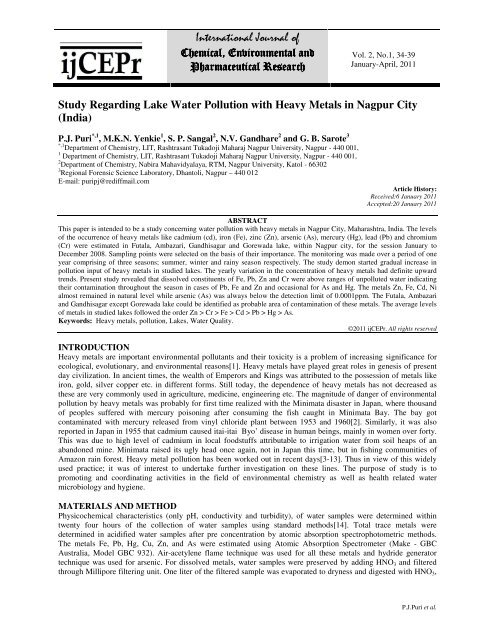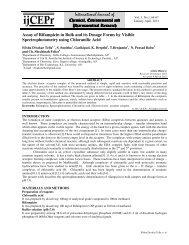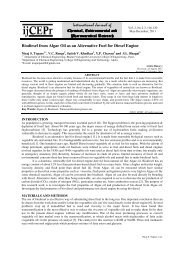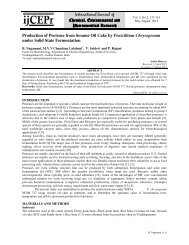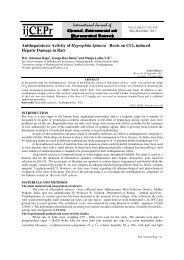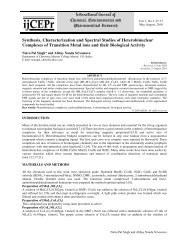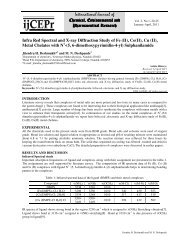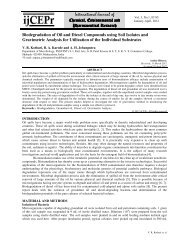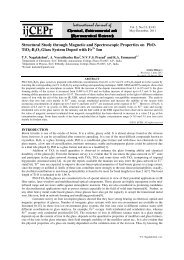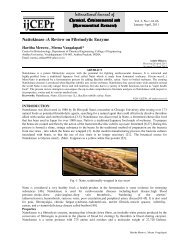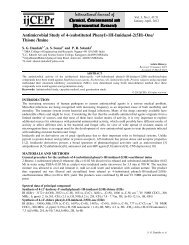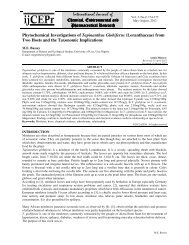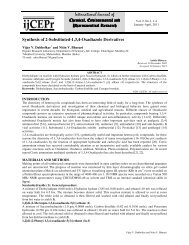Study Regarding Lake Water Pollution with Heavy Metals in Nagpur ...
Study Regarding Lake Water Pollution with Heavy Metals in Nagpur ...
Study Regarding Lake Water Pollution with Heavy Metals in Nagpur ...
Create successful ePaper yourself
Turn your PDF publications into a flip-book with our unique Google optimized e-Paper software.
International Journal of<br />
Chemical, Environmental and<br />
Pharmaceutical Research<br />
Vol. 2, No.1, 34-39<br />
January-April, 2011<br />
<strong>Study</strong> <strong>Regard<strong>in</strong>g</strong> <strong>Lake</strong> <strong>Water</strong> <strong>Pollution</strong> <strong>with</strong> <strong>Heavy</strong> <strong>Metals</strong> <strong>in</strong> <strong>Nagpur</strong> City<br />
(India)<br />
P.J. Puri *,1 , M.K.N. Yenkie 1 , S. P. Sangal 2 , N.V. Gandhare 2 and G. B. Sarote 3<br />
*,1 Department of Chemistry, LIT, Rashtrasant Tukadoji Maharaj <strong>Nagpur</strong> University, <strong>Nagpur</strong> - 440 001,<br />
1 Department of Chemistry, LIT, Rashtrasant Tukadoji Maharaj <strong>Nagpur</strong> University, <strong>Nagpur</strong> - 440 001,<br />
2 Department of Chemistry, Nabira Mahavidyalaya, RTM, <strong>Nagpur</strong> University, Katol - 66302<br />
3 Regional Forensic Science Laboratory, Dhantoli, <strong>Nagpur</strong> – 440 012<br />
E-mail: puripj@rediffmail.com<br />
Article History:<br />
Received:6 January 2011<br />
Accepted:20 January 2011<br />
ABSTRACT<br />
This paper is <strong>in</strong>tended to be a study concern<strong>in</strong>g water pollution <strong>with</strong> heavy metals <strong>in</strong> <strong>Nagpur</strong> City, Maharashtra, India. The levels<br />
of the occurrence of heavy metals like cadmium (cd), iron (Fe), z<strong>in</strong>c (Zn), arsenic (As), mercury (Hg), lead (Pb) and chromium<br />
(Cr) were estimated <strong>in</strong> Futala, Ambazari, Gandhisagar and Gorewada lake, <strong>with</strong><strong>in</strong> <strong>Nagpur</strong> city, for the session January to<br />
December 2008. Sampl<strong>in</strong>g po<strong>in</strong>ts were selected on the basis of their importance. The monitor<strong>in</strong>g was made over a period of one<br />
year compris<strong>in</strong>g of three seasons; summer, w<strong>in</strong>ter and ra<strong>in</strong>y season respectively. The study demon started gradual <strong>in</strong>crease <strong>in</strong><br />
pollution <strong>in</strong>put of heavy metals <strong>in</strong> studied lakes. The yearly variation <strong>in</strong> the concentration of heavy metals had def<strong>in</strong>ite upward<br />
trends. Present study revealed that dissolved constituents of Fe, Pb, Zn and Cr were above ranges of unpolluted water <strong>in</strong>dicat<strong>in</strong>g<br />
their contam<strong>in</strong>ation throughout the season <strong>in</strong> cases of Pb, Fe and Zn and occasional for As and Hg. The metals Zn, Fe, Cd, Ni<br />
almost rema<strong>in</strong>ed <strong>in</strong> natural level while arsenic (As) was always below the detection limit of 0.0001ppm. The Futala, Ambazari<br />
and Gandhisagar except Gorewada lake could be identified as probable area of contam<strong>in</strong>ation of these metals. The average levels<br />
of metals <strong>in</strong> studied lakes followed the order Zn > Cr > Fe > Cd > Pb > Hg > As.<br />
Keywords: <strong>Heavy</strong> metals, pollution, <strong>Lake</strong>s, <strong>Water</strong> Quality.<br />
©2011 ijCEPr. All rights reserved<br />
INTRODUCTION<br />
<strong>Heavy</strong> metals are important environmental pollutants and their toxicity is a problem of <strong>in</strong>creas<strong>in</strong>g significance for<br />
ecological, evolutionary, and environmental reasons[1]. <strong>Heavy</strong> metals have played great roles <strong>in</strong> genesis of present<br />
day civilization. In ancient times, the wealth of Emperors and K<strong>in</strong>gs was attributed to the possession of metals like<br />
iron, gold, silver copper etc. <strong>in</strong> different forms. Still today, the dependence of heavy metals has not decreased as<br />
these are very commonly used <strong>in</strong> agriculture, medic<strong>in</strong>e, eng<strong>in</strong>eer<strong>in</strong>g etc. The magnitude of danger of environmental<br />
pollution by heavy metals was probably for first time realized <strong>with</strong> the M<strong>in</strong>imata disaster <strong>in</strong> Japan, where thousand<br />
of peoples suffered <strong>with</strong> mercury poison<strong>in</strong>g after consum<strong>in</strong>g the fish caught <strong>in</strong> M<strong>in</strong>imata Bay. The bay got<br />
contam<strong>in</strong>ated <strong>with</strong> mercury released from v<strong>in</strong>yl chloride plant between 1953 and 1960[2]. Similarly, it was also<br />
reported <strong>in</strong> Japan <strong>in</strong> 1955 that cadmium caused itai-itai Byo’ disease <strong>in</strong> human be<strong>in</strong>gs, ma<strong>in</strong>ly <strong>in</strong> women over forty.<br />
This was due to high level of cadmium <strong>in</strong> local foodstuffs attributable to irrigation water from soil heaps of an<br />
abandoned m<strong>in</strong>e. M<strong>in</strong>imata raised its ugly head once aga<strong>in</strong>, not <strong>in</strong> Japan this time, but <strong>in</strong> fish<strong>in</strong>g communities of<br />
Amazon ra<strong>in</strong> forest. <strong>Heavy</strong> metal pollution has been worked out <strong>in</strong> recent days[3-13]. Thus <strong>in</strong> view of this widely<br />
used practice; it was of <strong>in</strong>terest to undertake further <strong>in</strong>vestigation on these l<strong>in</strong>es. The purpose of study is to<br />
promot<strong>in</strong>g and coord<strong>in</strong>at<strong>in</strong>g activities <strong>in</strong> the field of environmental chemistry as well as health related water<br />
microbiology and hygiene.<br />
MATERIALS AND METHOD<br />
Physicochemical characteristics (only pH, conductivity and turbidity), of water samples were determ<strong>in</strong>ed <strong>with</strong><strong>in</strong><br />
twenty four hours of the collection of water samples us<strong>in</strong>g standard methods[14]. Total trace metals were<br />
determ<strong>in</strong>ed <strong>in</strong> acidified water samples after pre concentration by atomic absorption spectrophotometric methods.<br />
The metals Fe, Pb, Hg, Cu, Zn, and As were estimated us<strong>in</strong>g Atomic Absorption Spectrometer (Make - GBC<br />
Australia, Model GBC 932). Air-acetylene flame technique was used for all these metals and hydride generator<br />
technique was used for arsenic. For dissolved metals, water samples were preserved by add<strong>in</strong>g HNO 3 and filtered<br />
through Millipore filter<strong>in</strong>g unit. One liter of the filtered sample was evaporated to dryness and digested <strong>with</strong> HNO 3 ,<br />
P.J.Puri et al.
Vol.2, No.1, 34-39 (2011)<br />
HCIO 4 mixture. The digested samples were made up to the volume and dissolved metals were analyzed by AAS.<br />
Iron, manganese and z<strong>in</strong>c were subjected to ten-fold concentration by evaporation. Cadmium, chromium, copper and<br />
lead were concentrated by complex<strong>in</strong>g <strong>with</strong> ammonium pyrrolid<strong>in</strong>e dithiocarbamate (APDC) and subsequently<br />
extract<strong>in</strong>g the complex <strong>in</strong> methyl isobutyl ketone (MIBK). Iron, manganese and z<strong>in</strong>c <strong>in</strong> aquatic solution and<br />
cadmium, chromium, copper and lead <strong>in</strong> organic solution, were determ<strong>in</strong>ed by atomiz<strong>in</strong>g respective solutions <strong>in</strong><br />
Atomic Absorption Spectrometer. The <strong>in</strong>strument was operated <strong>in</strong> flame mode us<strong>in</strong>g air as oxidant and acetylene as<br />
fuel Operation parameters were optimized for maximum response. Background correction was made for lead and<br />
cadmium and flame rich <strong>in</strong> acetylene was used for chromium determ<strong>in</strong>ation. <strong>Water</strong> samples were analyzed by both<br />
classical and automated <strong>in</strong>strumental methods as appropriated <strong>in</strong> standard methods for analysis of water and waste<br />
water[14]. All reagents used were of analytical grade and <strong>in</strong>struments pre-calibrated appropriately prior to<br />
measurement. Replicate analyses were carried out for each determ<strong>in</strong>ation to ascerta<strong>in</strong> reproducibility and quality<br />
assurance<br />
RESULTS AND DISCUSSION<br />
Seasonal variations were noted <strong>in</strong> the physicochemical properties of studied lake water Different properties like pH,<br />
EC, Temperature, HCO3 - and conductivity showed maximum values dur<strong>in</strong>g summer, while m<strong>in</strong>imum values were<br />
recorded dur<strong>in</strong>g autumn season. The observed trend could be attributed to the evaporation of water from studied lake<br />
(Gandhisagar, Ambazari, Futala and Gorewada <strong>Lake</strong>) dur<strong>in</strong>g summer and subsequent due to precipitation and runoff<br />
from catchment area dur<strong>in</strong>g ra<strong>in</strong>y season[15-16]. High pH values <strong>in</strong> all studied lakes dur<strong>in</strong>g summer could be<br />
ascribed to <strong>in</strong>creased photosynthetic assimilation of dissolved <strong>in</strong>organic carbon by planktons[17]. A similar effect<br />
could also be produced by water evaporation through loss of half bound CO 2 and precipitation of monocarbonate[18].<br />
The alkal<strong>in</strong>e pH and high alkal<strong>in</strong>ity of Futala, Ambazari and Gandhisagar lake water might be due to<br />
use of detergents by neighbor<strong>in</strong>g population for wash<strong>in</strong>g of cloths, vehicles, and utensils. Higher alkal<strong>in</strong>ity <strong>in</strong> Futala,<br />
Ambazari and Gandhisagar <strong>in</strong>dicated the potential susceptibility of these water bodies for eutrophication. <strong>Lake</strong> water<br />
bodies <strong>with</strong> alkal<strong>in</strong>ity values above 100 mgL -1 is considered nutritionally rich [19] and on the basis of this<br />
observation most of lakes <strong>in</strong> <strong>Nagpur</strong> city could be considered prone to eutrophication problems.<br />
Seasonal variation <strong>in</strong> different heavy metal concentration <strong>in</strong> water from Futala, Ambazari, Gandhisagar and<br />
Gorewada lake are presented <strong>in</strong> Table 1-4. Graphical representation of seasonal variation <strong>in</strong> different heavy metal<br />
concentration <strong>in</strong> water from Futala, Ambazari, Gandhisagar and Gorewada lake are presented <strong>in</strong> Figure1-4. Figure 5<br />
represents map show<strong>in</strong>g Gandhisagar, Ambazari, Gorewada and Futala lake, <strong>Nagpur</strong> (MS) India. The concentration<br />
of heavy meals <strong>in</strong> water of studied lakes rema<strong>in</strong>ed below toxic limits <strong>with</strong> few exceptions. A remarkable high<br />
concentration of (Fe) iron, ranged from 0.022 mgL -1 to 0.035 mgL -1 , 0.014 mgL -1 to 0.031 mgL -1 , 0.025 mgL -1<br />
to 0.031 mgL -1 and 0.012 mgL -1 to 0.016 mgL -1 <strong>in</strong> Futala, Gandhisagar, Ambazari and Gorewada lake<br />
respectively. The Fe content <strong>in</strong>dicated that this metal was abundant <strong>in</strong> soil and rocks of catchment area from where<br />
the water reaches to these lakes. As regards the effect of season on heavy metals concentration <strong>in</strong> water of Futala,<br />
Ambazari and Gorewada lakes, concentration of metals like Cd, Cr, Fe, Ni, Pb, Zn, Hg were maximum dur<strong>in</strong>g<br />
summer and ra<strong>in</strong>y season while m<strong>in</strong>imum concentrations were observed dur<strong>in</strong>g autumn season. This trend could be<br />
attributed to the evaporation of water from lakes dur<strong>in</strong>g summer and subsequent dilution due to precipitation and run<br />
off from catchment area dur<strong>in</strong>g ra<strong>in</strong>y season[20]. The variation of level of occurrence of heavy metal <strong>in</strong> Ambazari,<br />
Futala and Gandhisagar lake were found different from each other due to the variation of the solubility of the<br />
exist<strong>in</strong>g forms of metal <strong>in</strong> water as well as their availability <strong>in</strong> the immediate environment. Among metals the level<br />
of Z<strong>in</strong>c ranged from 0.025 mgL -1 to 0.0.048 mgL -1 , 0.016 mgL -1 to 0.041 mgL -1 , 0.021 mgL -1 to 0.032 mgL -1<br />
and 0.012 mgL -1 to 0.021 mgL -1 <strong>in</strong> Futala, Gandhisagar, Ambazari and Gorewada lake respectively. Arsenic (As)<br />
level was always less than 0.1ppb <strong>in</strong> Ambazari, Futala, Gorewada and Gandhisagar respectively. The average level<br />
of metals (<strong>in</strong> ppm) followed the similar order Zn > Cr > Fe > Cd > Pb > Hg > As for both Futala and Gandhisagar<br />
lake respectively. The ranges of variation <strong>in</strong> present study revealed that the dissolved constitutes of Pb, Cd, Zn, Cr<br />
and Zn was above the ranges of unpolluted water <strong>in</strong>dicat<strong>in</strong>g their contam<strong>in</strong>ation <strong>in</strong> water. Cadmium was detected <strong>in</strong><br />
traces and ranged from 0.010 mgL -1 to 0.012 mgL -1 , 0.004 mgL -1 to 0.008 mgL -1 , 0.003 mgL -1 to 0.016 mgL -1<br />
and 0.001 mgL -1 to 0.002 mgL -1 <strong>in</strong> Futala, Gandhisagar, Ambazari and Gorewada lake respectively. Cadmium is<br />
a non essential metal that is toxic even when present <strong>in</strong> very low concentration. The toxic effect of cadmium is<br />
exacerbated by the fact that it has an extremely long biological half – life and is therefore reta<strong>in</strong>ed for long periods<br />
of time <strong>in</strong> organisms after bioaccumulation. Cadmium is a respiratory poison and may contribute to high blood<br />
pressure and heart diseases[21]. Cadmium has been found to be toxic to fish and other aquatic organisms. Its effect<br />
on man <strong>in</strong>cludes kidney damage and serves pa<strong>in</strong> <strong>in</strong> bones (itai – itai <strong>in</strong> Japan). The level of lead (Pb) was higher<br />
dur<strong>in</strong>g summer and ra<strong>in</strong>y season as compared to autumn season <strong>in</strong> all studied lakes. Variations <strong>in</strong> lead (Pb) level<br />
35<br />
P.J.Puri et al.
Vol.2, No.1, 34-39 (2011)<br />
varied from 0.014 mgL -1 to 0.026 mgL -1 , 0.018 mgL -1 to 0.022 mgL -1 , 0.025 mgL -1 to 0.034 mgL -1 and 0.011<br />
mgL -1 to 0.021 mgL -1 <strong>in</strong> Futala, Gandhisagar, Ambazari and Gorewada lake respectively. Adverse Chronic effects<br />
may occur at 0.5 mgL -1 to 1.0 mgL -1 (Pb). At levels greater than 0.1 mgL -1 possible neurological damage <strong>in</strong><br />
fetuses and children may possible. The possible source of Pb <strong>in</strong> studied lakes could be from domestic sewage,<br />
immersion of idols of God and Goddess dur<strong>in</strong>g festival season and effluent discharge from waste disposal sites as<br />
well as geology of catchments. Chromium was detected <strong>with</strong> lower levels <strong>in</strong> autumn and higher throughout<br />
monitor<strong>in</strong>g period dur<strong>in</strong>g summer and ra<strong>in</strong>y season respectively. The heavy metals concentration <strong>in</strong> all studied lakes<br />
showed dist<strong>in</strong>ct temporal and spatial variations. Among metals, concentration of arsenic (As) rema<strong>in</strong>ed always<br />
below the detection level throughout study period <strong>in</strong> entire stretch except Futala and Ambazari lake. Thus it could be<br />
presumed that levels of (As) arsenic <strong>in</strong> Gorewada lake rema<strong>in</strong>ed almost <strong>in</strong> natural level and there was probably no<br />
anthropogenic <strong>in</strong>put <strong>in</strong> Gorewada lake for its enrichment. S<strong>in</strong>ce pH of studied lake water lies <strong>in</strong> the range of neutral<br />
to alkal<strong>in</strong>e the levels of studied metals could not rise so much as there are natural mechanism to remove these metals<br />
from aqueous solution and prevent from enrichment. A high degree of yearly variation was observed <strong>in</strong> z<strong>in</strong>c<br />
concentration. Its yearly variation showed an upward trend. In natural water system Zn rema<strong>in</strong>s as either hydroxide<br />
or carbonate form <strong>with</strong> hav<strong>in</strong>g almost same solubility which is higher than solubility of exist<strong>in</strong>g forms of other<br />
metals. This could be the reason for comparatively higher values of Zn <strong>in</strong> studied lake water. The average level of<br />
metals followed the order Zn > Cr > Fe > Cd > Pb > Hg > As for both Futala and Gorewada lake respectively.<br />
Higher values of metals <strong>in</strong> all studied lakes are due to wash<strong>in</strong>g activities, recreational activities, immersion of idols<br />
of God & Goddess dur<strong>in</strong>g and after festival seasons, vehicle wash<strong>in</strong>g, farm<strong>in</strong>g (agricultural) activities, weather<strong>in</strong>g of<br />
m<strong>in</strong>erals and soils, atmospheric deposition, storm water run off result<strong>in</strong>g from ra<strong>in</strong>fall, and (poor) sewage. Thus,<br />
water system <strong>with</strong> enriched toxic metals can serve as reservoirs and may becomes a potential source to supply toxic<br />
metals <strong>in</strong> the environment. chromium content <strong>in</strong> studied lakes ranges from 0.028 mgL -1 to 0.042 mgL -1 , 0.028<br />
mgL -1 to 0.036 mgL -1 , 0.014 mgL -1 to 0.028 mgL -1 and 0.016 mgL -1 to 0.018 mgL -1 <strong>in</strong> Futala, Gandhisagar,<br />
Ambazari and Gorewada lake respectively. Chromium <strong>in</strong>gestion over admissible limits leads to allergic phenomena<br />
and lung cancer. Mercury is considered to be the most toxic metal. In organic form it enters the human through fish.<br />
Fishes be<strong>in</strong>g one of ma<strong>in</strong> aquatic organism <strong>in</strong> food cha<strong>in</strong> may often accumulate large amount of certa<strong>in</strong> metals[22].<br />
Highly significant difference was noticed <strong>in</strong> case of mercury (Hg) <strong>in</strong> water samples collected from Futala, Ambazari<br />
and Gandhisagar lake. The concentration of mercury <strong>in</strong> water varied from 0.005 mgL -1 to 0.018 mgL -1 , 0.008<br />
mgL -1 to 0.018 mgL -1 , 0.010 mgL -1 to 0.021 mgL -1 and 0.001 mgL -1 to 0.003 mgL -1 <strong>in</strong> Futala, Gandhisagar,<br />
Ambazari and Gorewada lake respectively. The cont<strong>in</strong>uous <strong>in</strong>crease <strong>in</strong> heavy metal contam<strong>in</strong>ation <strong>in</strong> studied lake is<br />
a cause of concern as these metals have ability to bioaccumulate <strong>in</strong> tissues of various biota’s and may also affect<br />
distribution and density of benthic organisms as well as composition and diversity of faunal communities. S<strong>in</strong>ce pH<br />
and temperature affects solubility and toxicity of metals <strong>in</strong> aquatic ecosystem, this pH and temperature ranges were<br />
also used to access the metal toxicities <strong>in</strong> studied lakes. <strong>Metals</strong> such as Cd, Pb and Zn are most likely to have<br />
<strong>in</strong>creased detrimental environmental effects as a result of lowered pH..<br />
Season<br />
Table-1: <strong>Heavy</strong> metal content (ppm) dur<strong>in</strong>g different seasons of the year at Futala lake.<br />
<strong>Heavy</strong> <strong>Metals</strong> (mgL -1 )<br />
Zn Cr Fe Cd Pb As Hg<br />
Summer 0.048 0.042 0.035 0.012 0.026 BDL 0.018<br />
W<strong>in</strong>ter 0.025 0.039 0.022 0.010 0.014 BDL 0.005<br />
Ra<strong>in</strong>y 0.036 0.028 0.024 0.011 0.021 BDL 0.016<br />
BDL :Below Detectable Limit<br />
Table-2: <strong>Heavy</strong> metal content (ppm) dur<strong>in</strong>g different seasons of the year at Gandhisagar lake.<br />
Season<br />
<strong>Heavy</strong> <strong>Metals</strong> (mgL -1 )<br />
Zn Cr Fe Cd Pb As Hg<br />
Summer 0.041 0.036 0.031 0.008 0.022 BDL 0.012<br />
36<br />
P.J.Puri et al.
Vol.2, No.1, 34-39 (2011)<br />
W<strong>in</strong>ter 0.018 0.028 0.014 0.004 0.018 BDL 0.008<br />
Ra<strong>in</strong>y 0.016 0.030 0.018 0.006 0.020 BDL 0.018<br />
BDL :Below Detectable Limit<br />
Table-3: <strong>Heavy</strong> metal content (ppm) dur<strong>in</strong>g different seasons of the year at Ambazari lake.<br />
Season<br />
<strong>Heavy</strong> <strong>Metals</strong> (mgL -1 )<br />
Zn Cr Fe Cd Pb As Hg<br />
Summer 0.032 0.028 0.025 0.005 0.031 BDL 0.016<br />
W<strong>in</strong>ter 0.025 0.016 0.029 0.003 0.025 BDL 0.010<br />
Ra<strong>in</strong>y 0.021 0.014 0.031 0.016 0.034 BDL 0.021<br />
BDL :Below Detectable Limit<br />
Table-4: <strong>Heavy</strong> metal content (ppm) dur<strong>in</strong>g different seasons of the year at Gorewada lake.<br />
Season<br />
<strong>Heavy</strong> <strong>Metals</strong> (mgL -1 )<br />
Zn Cr Fe Cd Pb As Hg<br />
Summer 0.018 0.020 0.011 0.002 0.016 BDL 0.001<br />
W<strong>in</strong>ter 0.012 0.018 0.012 0.001 0.014 BDL 0.001<br />
Ra<strong>in</strong>y 0.020 0.013 0.001 0.010 0.002 BDL 0.003<br />
BDL :Below Detectable Limit<br />
Fig-1: <strong>Heavy</strong> metal content (ppm) dur<strong>in</strong>g different seasons of the year at Futala lake.<br />
Concentration (ppm)<br />
0.06<br />
0.04<br />
0.02<br />
0<br />
Zn Cr Fe Cd Pb Hg As<br />
<strong>Heavy</strong> <strong>Metals</strong><br />
Summer<br />
W<strong>in</strong>ter<br />
Ra<strong>in</strong>y<br />
Fig.-2: <strong>Heavy</strong> metal content (ppm) dur<strong>in</strong>g different seasons of the year at Gandhisagar lake.<br />
37<br />
P.J.Puri et al.
Vol.2, No.1, 34-39 (2011)<br />
Fig.-3: <strong>Heavy</strong> metal content (ppm) dur<strong>in</strong>g different seasons of the year at Ambazari lake.<br />
Fig.-4: <strong>Heavy</strong> metal content (ppm) dur<strong>in</strong>g different seasons of the year at Gorewada lake.<br />
CONCLUSION<br />
The heavy metal concentration <strong>in</strong> studied lake showed dist<strong>in</strong>ct temporal and spatial variations. There was significant<br />
seasonal variation <strong>in</strong> metal concentration <strong>with</strong><strong>in</strong> the study period. The dry season registered elevated levels of metals<br />
as compared to wet season. Dilution effect of ra<strong>in</strong>y season due to storm run off <strong>in</strong>to receiv<strong>in</strong>g lakes and excessive<br />
evaporation of surface water <strong>with</strong> its attendant pre-concentration of most of metals may be responsible for<br />
observed trend. The results of study have <strong>in</strong>dicated gross pollution of lakes especially regards heavy metals. This<br />
poses a healthy risk to several communities <strong>in</strong> catchment who rely on these lakes primarily for their domestic<br />
sources <strong>with</strong>out treatment. An elevated level of heavy metals <strong>in</strong> water is a good <strong>in</strong>dication of man – <strong>in</strong>duced<br />
pollution as a result of (poor) sewage, domestic waste and immersion of idols of God and Goddess dur<strong>in</strong>g and after<br />
festival season <strong>in</strong>to studied lakes. There were def<strong>in</strong>ite upward yearly trends <strong>in</strong> the concentration of chromium, iron,<br />
lead and z<strong>in</strong>c <strong>in</strong> studied lakes which <strong>in</strong>dicated <strong>in</strong>creased <strong>in</strong>put of their pollution load. The levels of mercury (Hg)<br />
and arsenic (As) <strong>in</strong> studied lake water were comparatively lower. The average level of metals followed the order Zn<br />
> Cr > Fe > Cd > Pb > Hg > As and for all studied lakes. Through some of detected heavy metals are beneficial for<br />
human and plants up to a certa<strong>in</strong> limit; it may be harmful beyond that. Adoption of adequate measures to remove<br />
heavy metals load from <strong>in</strong>dustrial waste water, prevention of immersion of idols of God and Goddess along <strong>with</strong><br />
fruits, flowers and worship materials along <strong>with</strong> wash<strong>in</strong>g activities are suggested to avoid further deterioration of<br />
lake water quality.<br />
ACKNOWLEDGMENTS<br />
The authors hereby acknowledge the k<strong>in</strong>d and wholehearted support of the Dr. S. B. Gholse Director, LIT, RTM,<br />
<strong>Nagpur</strong> University, <strong>Nagpur</strong>.<br />
REFERENCE<br />
1. Nagajyoti, P.C., D<strong>in</strong>akar, N., Prasad, T.N.V.K.V., Journal of Applied Sciences Research, 4(1) (2008) 110.<br />
2. Friedman, M., Environ. Sci. Technol., 6 (5) (1972) 457.<br />
3. Akeson, M. and D. Munns, Journal Plant Nutri., 13 (1990) 467.<br />
4. Anderson, A. and K. O. Nilsson, Sewish Jounal Agricult. Res., 6 (1976) 15.<br />
5. Antonovics, J., A. D. Bradshw and B.G. Turner : Adv. Ecol. Res., 7 (1975) 1.<br />
38<br />
P.J.Puri et al.
Vol.2, No.1, 34-39 (2011)<br />
6. Asami Teuro: Sci. Res. Fac. Agric,. Iberaki Univ ., 23 (1975) 43.<br />
7. Azad, A.S., B.R. Arora, B. S<strong>in</strong>gh and G.S. Sekhon: Ind. J. Ecol., II (1) (1984) 1.<br />
8. Borovik, A.S., CRC Press Boca Raton. Florida, 3-5 (1990).<br />
9. Bowen, J. E. : Plant Physiol, 44 (1973) 255.<br />
10. Dutta, I. and Mookerjee, A., Indian J. Environ. Health, 22(3) (1980) 220.<br />
11. Fytianos, K., V. Samanidou and T. Agelidis, Ambia 15 (1) (1986) 42.<br />
12. Mc. Calla, T.M., J.R. Perterson and C.I., Lue ; Ed. Elliot, L.F. and F.J. Stevensn, Sashngton, 28-36 (1977).<br />
13. Vander Werff, M. and J. P. Margaret : Chemosphere. 11(8). (1982).<br />
14. APHA; Standards Methods for the exam<strong>in</strong>ation of water and waste water, 18 th edition, (1998).<br />
15. Wiklander, L. and Kantol Vahtras : Geoderma 19 (2) (1977) 123.<br />
16. Radhika, C. G. M<strong>in</strong>i, J., & Gangaderr, T.: <strong>Pollution</strong> Research, 23, (2004) 49.<br />
17. K<strong>in</strong>g, D.L., Journal for the <strong>Water</strong> <strong>Pollution</strong> Control Federation , 42(1970) 2035.<br />
18. Khan, M.A. G., & Choudhary, S.H., Tropical Ecology, 35, (1994) 35.<br />
19. Patil, P.R., Chaudhari, D.N. & K<strong>in</strong>age, M.S. Environemental Ecology, 22, (2004) 65.<br />
20. Bhatt, L.R. Lacoul, P., Lekhak, H.D., & Jha, P.K. : <strong>Pollution</strong> Research, 18 (1999) 353.<br />
21. Friberg, L. and C. J. El<strong>in</strong>der; Health and Diseases, 18 (1988) 559.<br />
22. Purandara, B.K., Vararajan, N. and Jayashree K. Poll., Res, 22 (2) (2003) 189.<br />
Fig. -5: Map show<strong>in</strong>g Gandhisagar, Ambazari, Gorewada and Futala <strong>Lake</strong>, <strong>Nagpur</strong> (MS) India.<br />
[IJCEPR-142/2011]<br />
39<br />
P.J.Puri et al.


